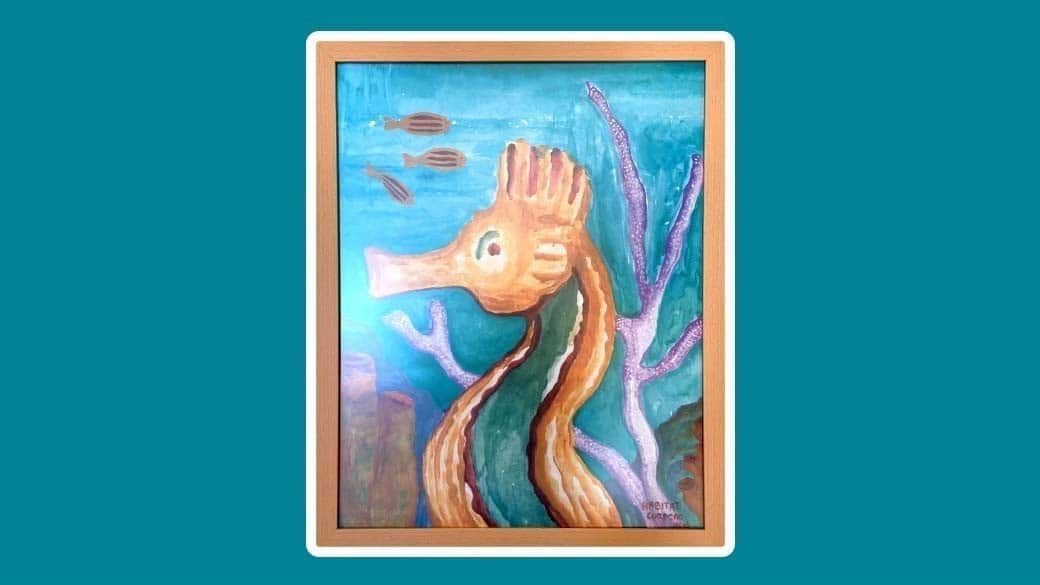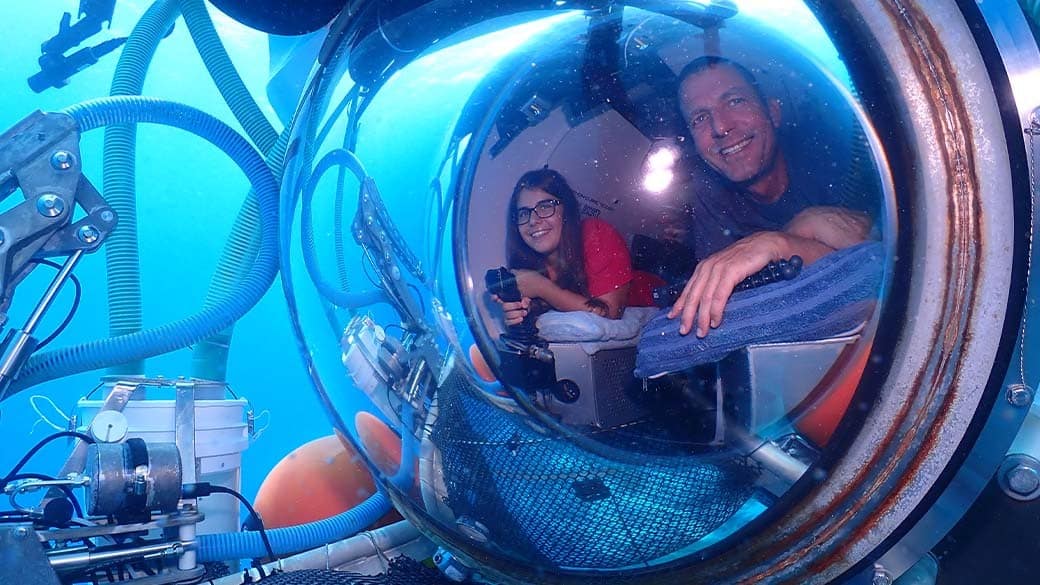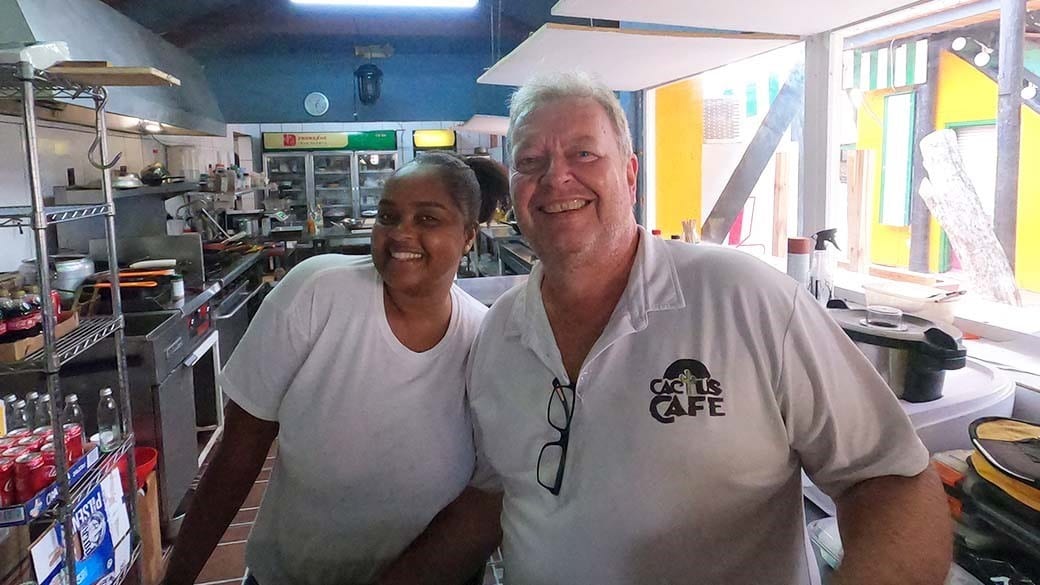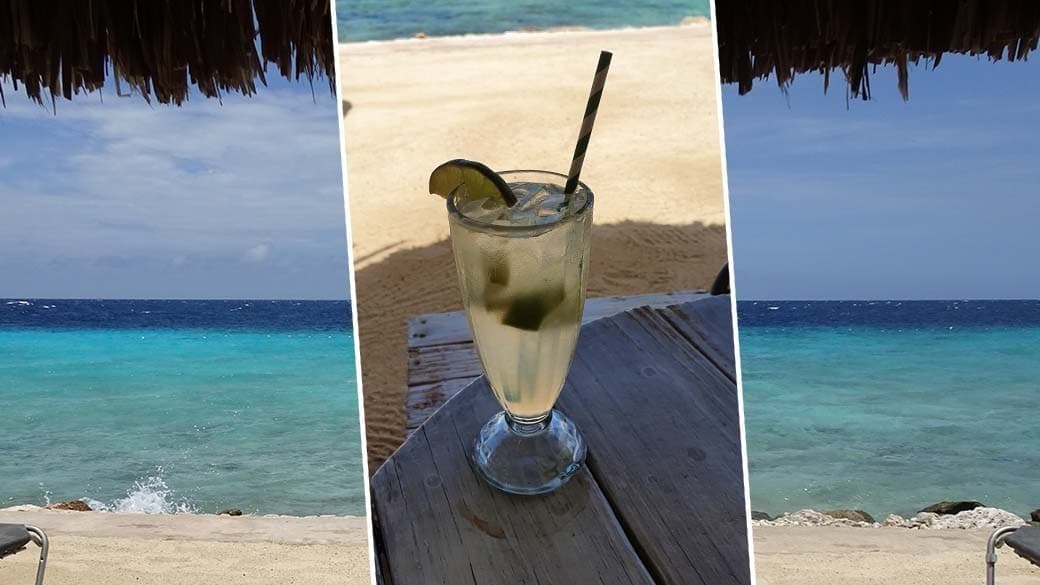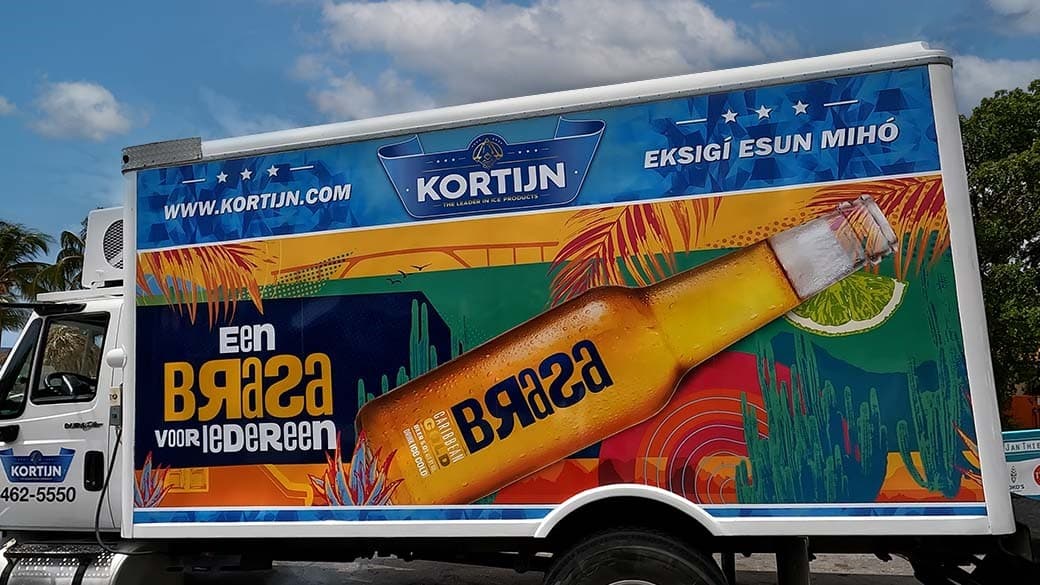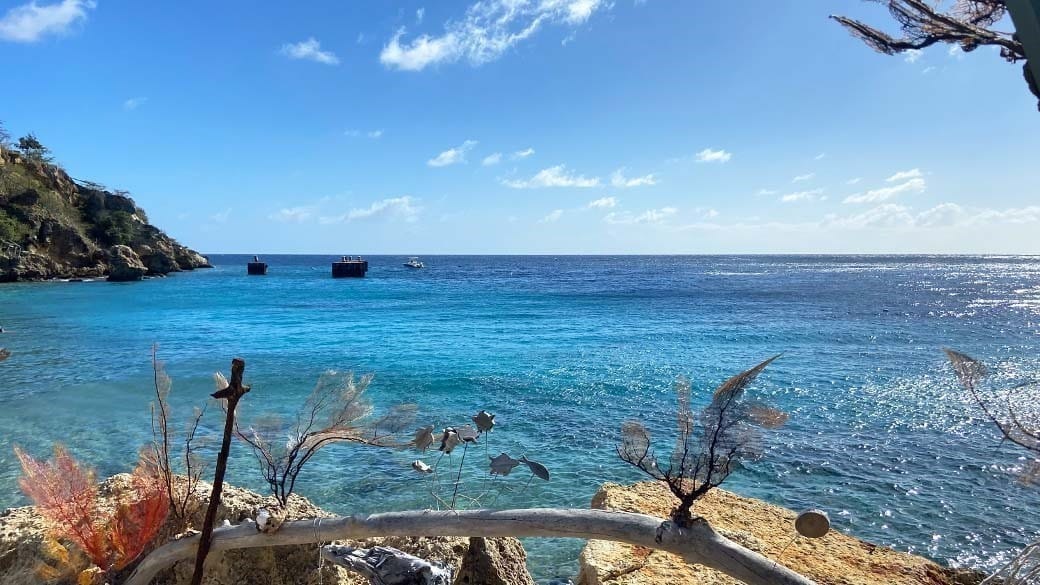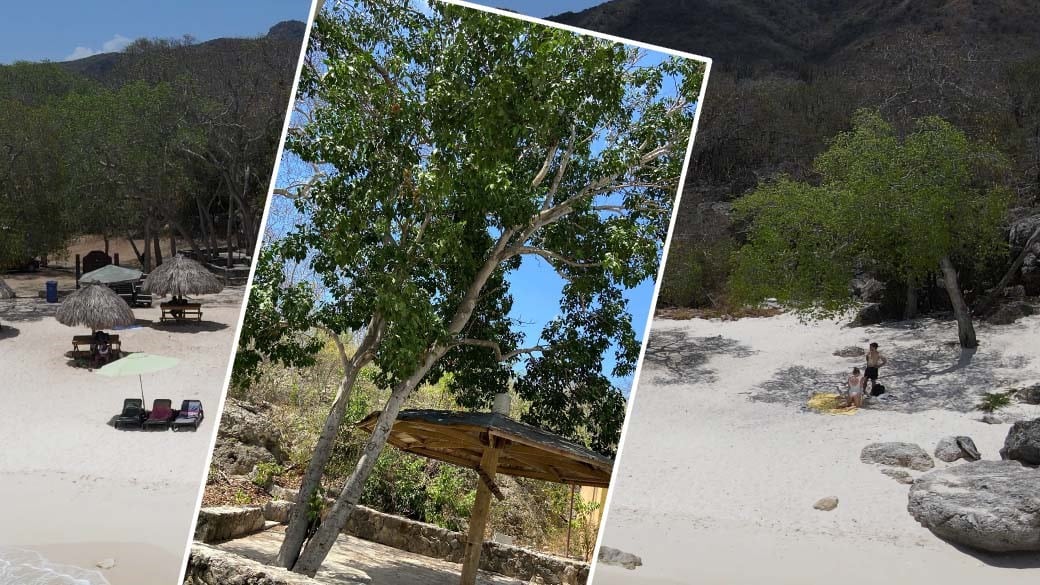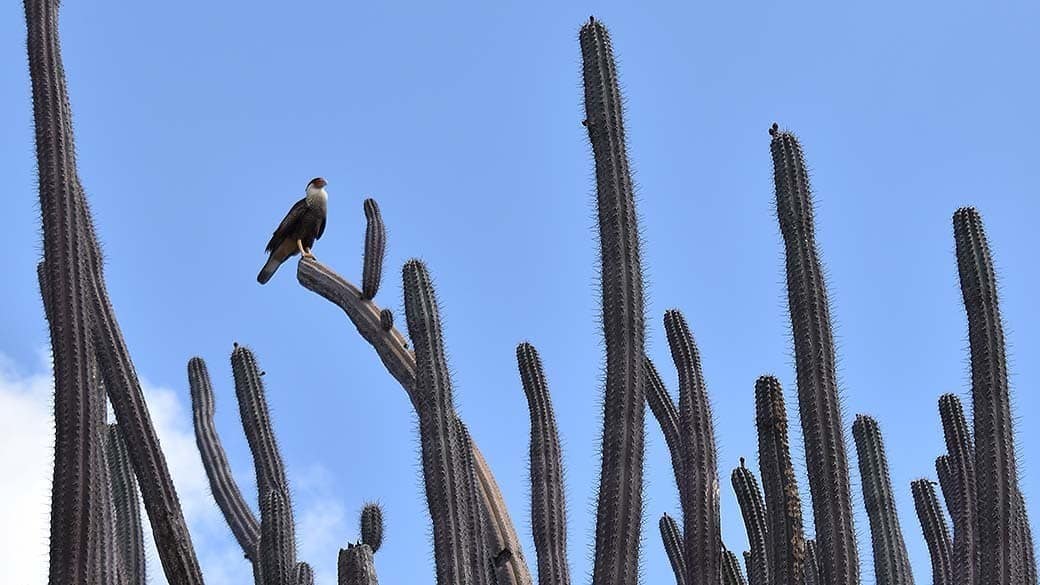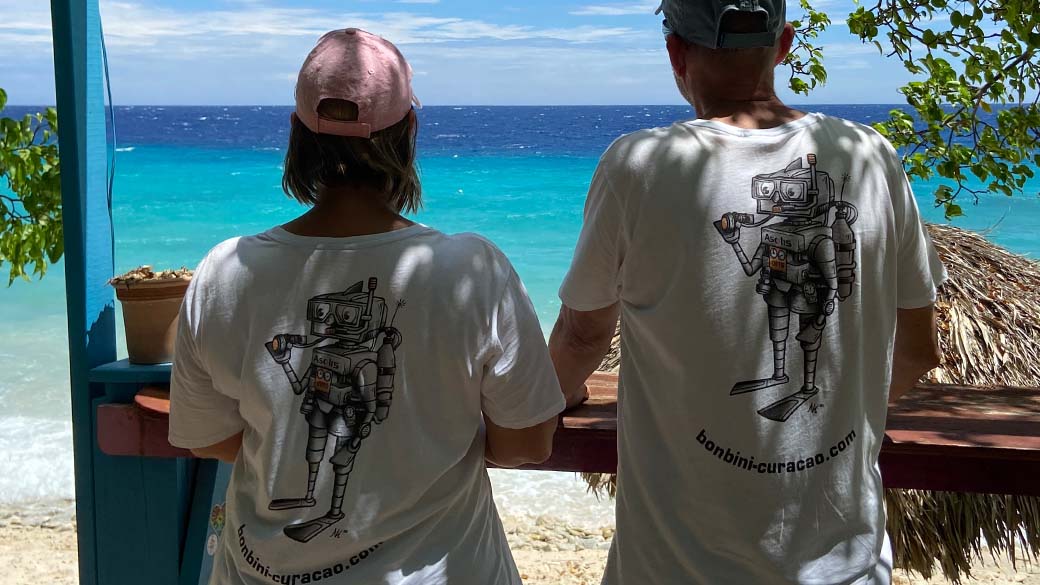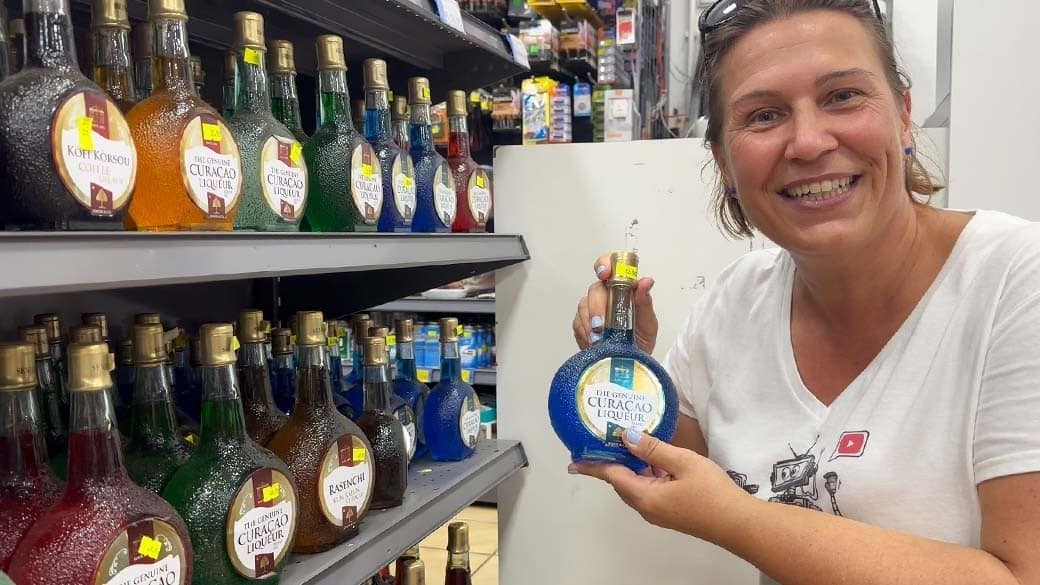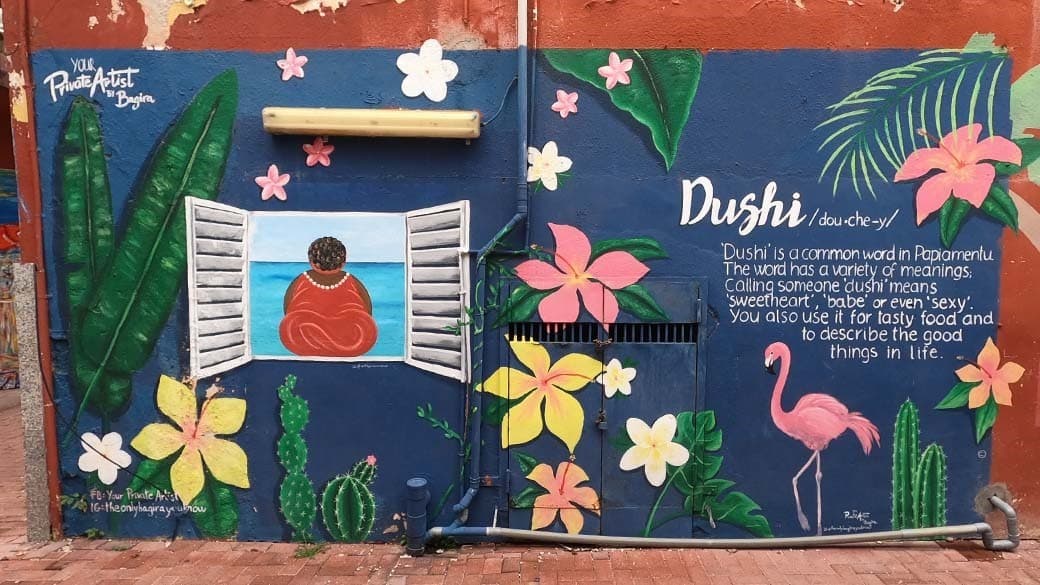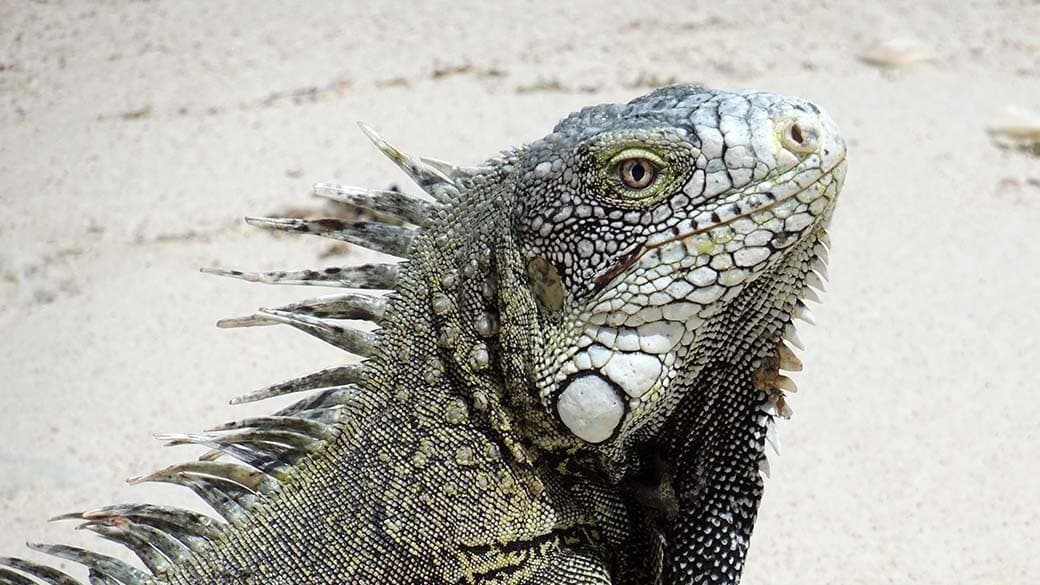Seahorses in Curacao
Underwater love with so much gut feeling
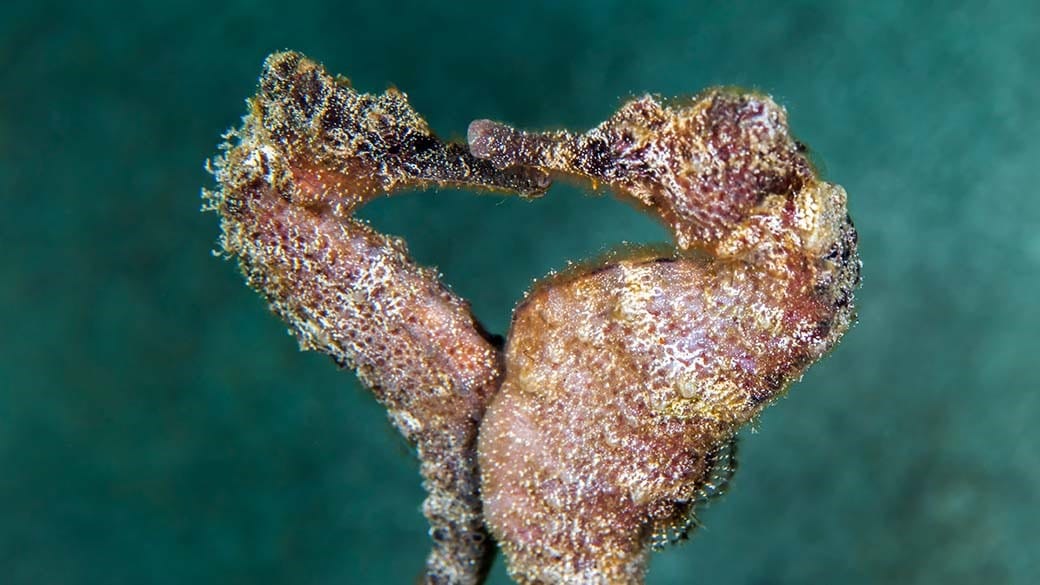
“I love seahorses! They are my absolute favorites underwater.”
For years, I have never missed an opportunity to look for seahorses anywhere in the world. In aquariums, when diving, on television … They fascinate me and are my absolute favorite animals. There’s a picture of a seahorse by the painter Nena Sanchez hanging in our living room. Do they exist on Curacao? Have I found one? Stay tuned!
Seahorses on Curacao – myth or reality
For years I have been searching underwater all over the world for the hippocampus (=zoological name). In Greek mythology, hippocampi are the mounts of the sea gods. That reminds me: Have you seen Aquaman? In the movie, the people of the red-haired King Nereus, played by Dolph Lundgren, ride oversized seahorses.
I’m really excited about the animals because they look like they’re from another planet or mythical creatures. If I hadn’t already seen one, I’d think seahorses on Curacao were a myth.
A needle in a haystack
I’m more likely to see sea needles than seahorses underwater on our travels. These are seahorses without curves or a big belly. I don’t find them quite as exciting.
The only time I saw a seahorse in the wild on Curacao was during a night dive on the Sint Marie reef. Our guide raised his forearms in front of his chest and gave the underwater hand signal for seahorses. He pointed to an underwater plant.
I had to look very closely in the light of the lamp: the mini sea monster was hanging from one of the countless branches. This find was the highlight of the day for everyone in the diving group. Do I have a photo of it? Unfortunately I don’t. 😢
It’s tough to get a shot of seahorses
These cute little guys can change color and adapt to their surroundings, which makes them virtually invisible.
If you want to find seahorses and capture them in pictures, you need a trained eye, patience, and calm. Our partners Yvonne and Tilo from NaturePicsFilms have all. Hardly unbelievable: they even took all the underwater pictures and the seahorse video at the end of the article on Curacao.
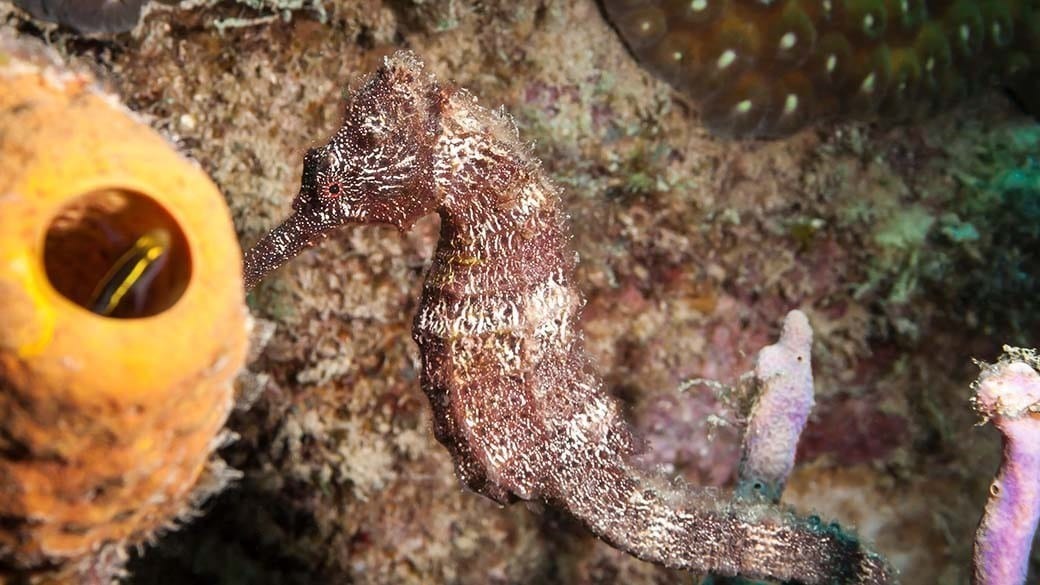
Seahorse in front of a yellow tube sponge – NaturePicsFilms
On a treasure hunt
There are supposed to be seahorses near the pier at Tugboat Beach. That’s what Maren told us on our last visit when she showed us the snorkeling route on a treasure map.
We have dived there before, but on the steep wall further ahead and not on the side of the pier. It’s pretty dark in the shade of the pier, so a diving torch would be useful next time. We definitely need to go back to find my personal treasure.
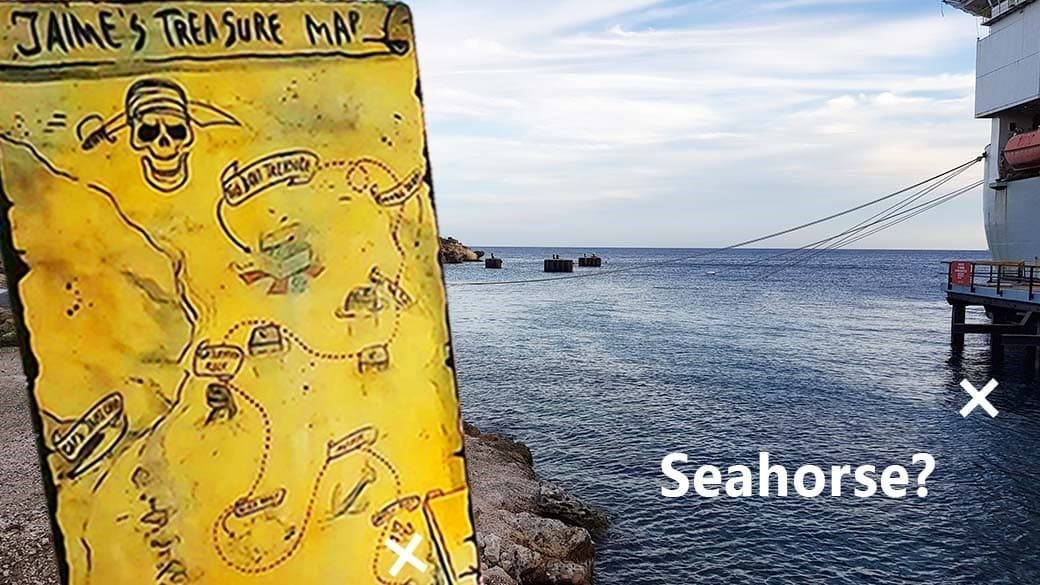
Place of discovery as marked on the pirate treasure map of Tugboat Beach
Vacation reading
If I can’t find them in the water while snorkeling and diving, I try to take home some other memories of seahorses in Curacao.
I picked up a wonderful souvenir in the Coral Estate Resort store: a thriller called ‘Het Zeepaardje’. This is Dutch and translates as ‘The Seahorse’. The book is by local author Eugénie Brands and is about diving. The fact that the main character is on vacation at this resort on Curacao and is taking her first diving course there gives the novel an authentic feel. Her excursions to well-known POIs on the island remind me of my own visits and experiences. For me, it was an incentive to finally learn the language.
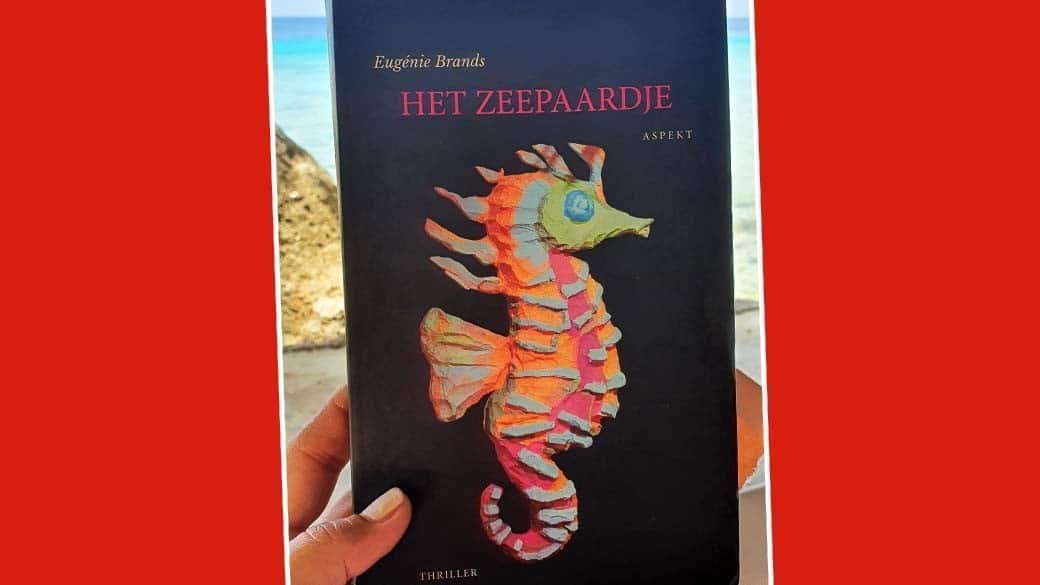
Here’s the cover of the Dutch-language book
Seahorse Beach Sign
I picked up a souvenir of decorative nature in connection with seahorses from Signs & Crafts in Punda. Shirley Wimpel, an artist from Suriname, makes beach signs from driftwood in her studio. She made my individual nameplate for our post outside the front door. Of course, that was the brief. I should mention that I love seahorses? 😉

Having beach signs right outside your door makes you feel good
Mind games
Years ago, we visited the Nena Sanchez Gallery in the Jan Kok country house near Sint Willibrordus. There was a stack of art prints with a seahorse motif on a large, solid table. At first glance, I could already see the seahorse in my mind’s eye hanging on the wall at home. I then tried to convince my family that this picture would fit in perfectly in our home – if only because of the great colors. In reality, I had already fallen in love with it.
But it was a pretty big poster, and how were we going to get it to Germany safely? So it had to stay there.
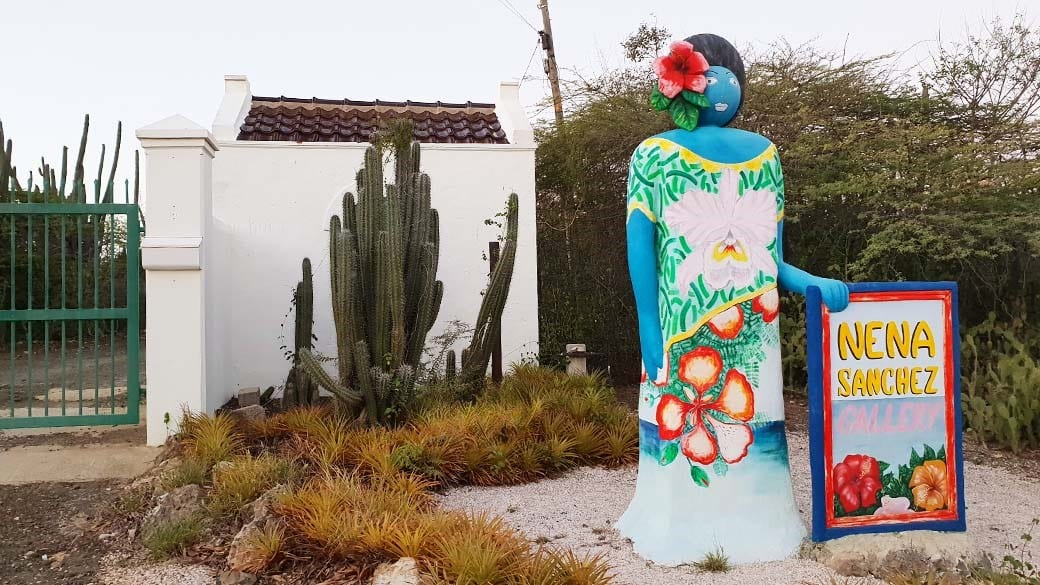
Entrance to Nena Sanchez Gallery
Head through the wall
I couldn’t get the poster out of my mind. I asked Stefan to stop by the gallery one more time to buy it before we left. Welcome, transportation problem! To be able to do something with it at home, the poster had to be rolled up and not folded into the luggage: my hand luggage or accessory on the KLM flight home. I was one of those people you shake your head at when you see them trying to transport a piece of paper undamaged on an airplane.
It was quite a dilemma for me because it was hard to find finding a suitable frame for my seahorse. I had to cut it to size, so it didn’t go without collateral damage. You can just make out the signature HABITAT CURACAO now. Coincidentally, the former Habitat Hotel was our vacation home at the time, the Coral Estate Resort, after conversion and renovation. The following photo montage shows the shore of the hotel complex from the water with my seahorse picture from our living room:
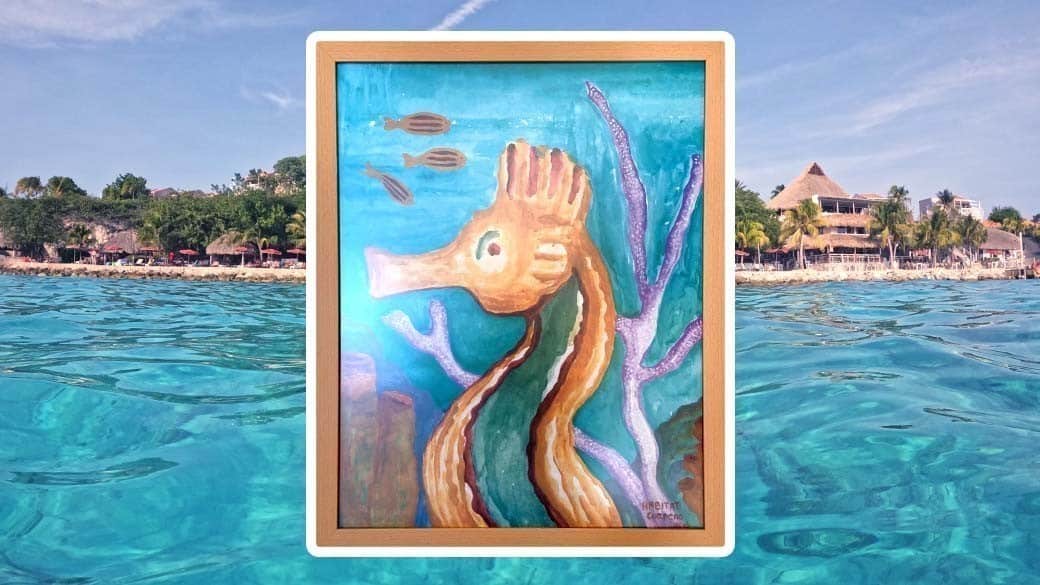
Seahorse picture with a very special story
Horseback riding
Seahorses swim vertically in the water – you don’t make very good progress. I’ve experienced this myself when aqua jogging. 🙂
Although they flap their little fins 35 times a second (thanks to our partner Go West Diving for this new piece of information), there is no horsepower to speak of, but rather a snail’s pace. That’s why seahorses are quite localized, but they know their home like the back of their hand.
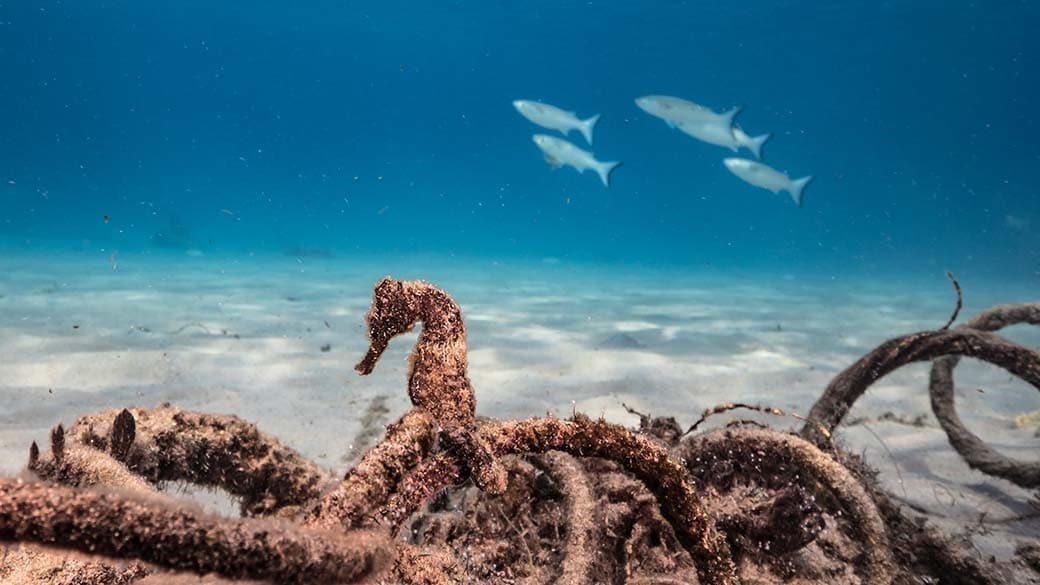
The seahorse’s upright gait – NaturePicsFilms
Shopping Queen
The “fashionable” seahorse man always carries a bag with him, the so-called belly bag. He can puff it up mightily at the bridal show, as if to say:
“Look, I can fit a lot in this bag – I’m going to be a good father.”
In fact, the female lays her eggs there, like brood care in reverse. The male fertilizes the eggs inside himself, hatches them and gives birth to live young.
You are my Dancing Queen!
When it comes to dancing, no other (fish) can beat the seahorse. They are real belly dancers: when making love, they take on the same color, face each other, nestle their bellies close together and thus form a heart. Once a dancing couple has found each other, they stay together for life.

Belly dance of love – female on the left, male on the right – NaturePicsFilms
Underwater romance
Seahorses renew their love every day by performing the same ritual every morning: They start the day with a little dance, showing their bellies to each other. Only then do they go out separately in search of food.
Is this a concept for eternal love? It is said that the female will look for a new partner for her eggs if the male weakens. This happens in the best families.
Musical kinship
It’s interesting to note that I would not have known this without a post by Ocean Encounters: Seahorses are related to flutefish and trumpetfish.
How can you tell? They all have a toothless, elongated mouth. The mouth of the flutefish and trumpetfish resembles the mouthpiece of the corresponding musical instruments. They also catch their prey in the same way: they simply suck the prey in. They are also good at camouflaging themselves and rearing their young is also a male job.

A trumpet fish on Curacao is upside down
Caviar and crustaceans – only the finest
Seahorses live on coral reefs and in seagrass. The latter is less common on Curacao, but in principle they like to be where they can camouflage themselves well and hold on with their coiled tail. There they wait until their table sets itself. At some point, the prey swims right past.
The menu of the ‘Cabai di Awa’, as the seahorse is called on Papiamentu, includes small crustaceans and fish larvae. At first they fixate on these with their cute saucer eyes. What’s kind of weird is that they can move their eyes independently of each other – like chameleons. Then they snap at lightning speed with their snout. Their voracious appetite allows them to eat up to 50 times a day, which makes them even more likeable, but it could be stressful.

Cling, camouflage and wait for prey – NaturePicsFilms
Heart’s desire
I’m keeping my fingers crossed that you’ll be lucky enough to meet a seahorse on Curacao. 💓🌊🐴
If you’ve seen a seahorse on a beach or at a diving spot, please leave a comment with the location. We can then collect the various locations on Curacao and share them here.
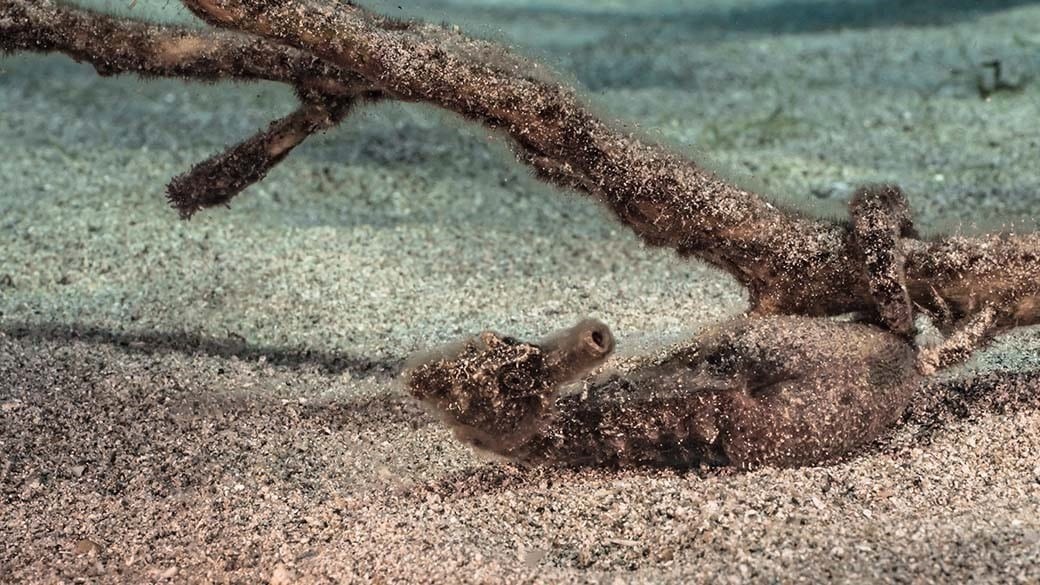
ROFL – it’s all a question of camouflage – NaturePicsFilms
In the meantime, take some time to relax, just like the little seahorse in the photo. You might want to check out this video “Calming Down in the Ocean”:
Do you know the answer? We collected 100+ entertaining questions about Curacao. Have fun!
Quiz Question
What does NAF or NAFL stand for?Answer
Netherlands Antilles Florin – Florin Antiano, the currency unit on Curacao.
Naf. or Nafl. is the abbreviation for the Dutch Antillean Guilder (ANG).
In Papiamentu they say Florin or Heldu. You will also often hear Gilders or ‘Güldis’, which means (Antillean) Guilders.
Do you like more? Here is another post you might be interested in:
If you enjoyed this article, we would be very happy if you share it with your friends on social media. Thank you very much!
Enough of being under water? How about a little relaxation on the snow-white beaches of Curacao? Or a few tips for a trip? Feel free to browse our lifestyle, shopping or nature sections. In the secrets category, we’ll tell you what you may not yet know about the heart of the Caribbean.
Seahorses in Curacao
Underwater love with so much gut feeling

“I love seahorses! They are my absolute favorites underwater.”
For years, I have never missed an opportunity to look for seahorses anywhere in the world. In aquariums, when diving, on television … They fascinate me and are my absolute favorite animals. There’s a picture of a seahorse by the painter Nena Sanchez hanging in our living room. Do they exist on Curacao? Have I found one? Stay tuned!
Seahorses on Curacao – myth or reality
For years I have been searching underwater all over the world for the hippocampus (=zoological name). In Greek mythology, hippocampi are the mounts of the sea gods. That reminds me: Have you seen Aquaman? In the movie, the people of the red-haired King Nereus, played by Dolph Lundgren, ride oversized seahorses.
I’m really excited about the animals because they look like they’re from another planet or mythical creatures. If I hadn’t already seen one, I’d think seahorses on Curacao were a myth.
A needle in a haystack
I’m more likely to see sea needles than seahorses underwater on our travels. These are seahorses without curves or a big belly. I don’t find them quite as exciting.
The only time I saw a seahorse in the wild on Curacao was during a night dive on the Sint Marie reef. Our guide raised his forearms in front of his chest and gave the underwater hand signal for seahorses. He pointed to an underwater plant.
I had to look very closely in the light of the lamp: the mini sea monster was hanging from one of the countless branches. This find was the highlight of the day for everyone in the diving group. Do I have a photo of it? Unfortunately I don’t. 😢
It’s tough to get a shot of seahorses
These cute little guys can change color and adapt to their surroundings, which makes them virtually invisible.
If you want to find seahorses and capture them in pictures, you need a trained eye, patience, and calm. Our partners Yvonne and Tilo from NaturePicsFilms have all. Hardly unbelievable: they even took all the underwater pictures and the seahorse video at the end of the article on Curacao.

Seahorse in front of a yellow tube sponge – NaturePicsFilms
On a treasure hunt
There are supposed to be seahorses near the pier at Tugboat Beach. That’s what Maren told us on our last visit when she showed us the snorkeling route on a treasure map.
We have dived there before, but on the steep wall further ahead and not on the side of the pier. It’s pretty dark in the shade of the pier, so a diving torch would be useful next time. We definitely need to go back to find my personal treasure.

Place of discovery as marked on the pirate treasure map of Tugboat Beach
Vacation reading
If I can’t find them in the water while snorkeling and diving, I try to take home some other memories of seahorses in Curacao.
I picked up a wonderful souvenir in the Coral Estate Resort store: a thriller called ‘Het Zeepaardje’. This is Dutch and translates as ‘The Seahorse’. The book is by local author Eugénie Brands and is about diving. The fact that the main character is on vacation at this resort on Curacao and is taking her first diving course there gives the novel an authentic feel. Her excursions to well-known POIs on the island remind me of my own visits and experiences. For me, it was an incentive to finally learn the language.

Here’s the cover of the Dutch-language book
Seahorse Beach Sign
I picked up a souvenir of decorative nature in connection with seahorses from Signs & Crafts in Punda. Shirley Wimpel, an artist from Suriname, makes beach signs from driftwood in her studio. She made my individual nameplate for our post outside the front door. Of course, that was the brief. I should mention that I love seahorses? 😉

Having beach signs right outside your door makes you feel good
Mind games
Years ago, we visited the Nena Sanchez Gallery in the Jan Kok country house near Sint Willibrordus. There was a stack of art prints with a seahorse motif on a large, solid table. At first glance, I could already see the seahorse in my mind’s eye hanging on the wall at home. I then tried to convince my family that this picture would fit in perfectly in our home – if only because of the great colors. In reality, I had already fallen in love with it.
But it was a pretty big poster, and how were we going to get it to Germany safely? So it had to stay there.

Entrance to Nena Sanchez Gallery
Head through the wall
I couldn’t get the poster out of my mind. I asked Stefan to stop by the gallery one more time to buy it before we left. Welcome, transportation problem! To be able to do something with it at home, the poster had to be rolled up and not folded into the luggage: my hand luggage or accessory on the KLM flight home. I was one of those people you shake your head at when you see them trying to transport a piece of paper undamaged on an airplane.
It was quite a dilemma for me because it was hard to find finding a suitable frame for my seahorse. I had to cut it to size, so it didn’t go without collateral damage. You can just make out the signature HABITAT CURACAO now. Coincidentally, the former Habitat Hotel was our vacation home at the time, the Coral Estate Resort, after conversion and renovation. The following photo montage shows the shore of the hotel complex from the water with my seahorse picture from our living room:

Seahorse picture with a very special story
Horseback riding
Seahorses swim vertically in the water – you don’t make very good progress. I’ve experienced this myself when aqua jogging. 🙂
Although they flap their little fins 35 times a second (thanks to our partner Go West Diving for this new piece of information), there is no horsepower to speak of, but rather a snail’s pace. That’s why seahorses are quite localized, but they know their home like the back of their hand.

The seahorse’s upright gait – NaturePicsFilms
Shopping Queen
The “fashionable” seahorse man always carries a bag with him, the so-called belly bag. He can puff it up mightily at the bridal show, as if to say:
“Look, I can fit a lot in this bag – I’m going to be a good father.”
In fact, the female lays her eggs there, like brood care in reverse. The male fertilizes the eggs inside himself, hatches them and gives birth to live young.
You are my Dancing Queen!
When it comes to dancing, no other (fish) can beat the seahorse. They are real belly dancers: when making love, they take on the same color, face each other, nestle their bellies close together and thus form a heart. Once a dancing couple has found each other, they stay together for life.

Belly dance of love – female on the left, male on the right – NaturePicsFilms
Underwater romance
Seahorses renew their love every day by performing the same ritual every morning: They start the day with a little dance, showing their bellies to each other. Only then do they go out separately in search of food.
Is this a concept for eternal love? It is said that the female will look for a new partner for her eggs if the male weakens. This happens in the best families.
Musical kinship
It’s interesting to note that I would not have known this without a post by Ocean Encounters: Seahorses are related to flutefish and trumpetfish.
How can you tell? They all have a toothless, elongated mouth. The mouth of the flutefish and trumpetfish resembles the mouthpiece of the corresponding musical instruments. They also catch their prey in the same way: they simply suck the prey in. They are also good at camouflaging themselves and rearing their young is also a male job.

A trumpet fish on Curacao is upside down
Caviar and crustaceans – only the finest
Seahorses live on coral reefs and in seagrass. The latter is less common on Curacao, but in principle they like to be where they can camouflage themselves well and hold on with their coiled tail. There they wait until their table sets itself. At some point, the prey swims right past.
The menu of the ‘Cabai di Awa’, as the seahorse is called on Papiamentu, includes small crustaceans and fish larvae. At first they fixate on these with their cute saucer eyes. What’s kind of weird is that they can move their eyes independently of each other – like chameleons. Then they snap at lightning speed with their snout. Their voracious appetite allows them to eat up to 50 times a day, which makes them even more likeable, but it could be stressful.

Cling, camouflage and wait for prey – NaturePicsFilms
Heart’s desire
I’m keeping my fingers crossed that you’ll be lucky enough to meet a seahorse on Curacao. 💓🌊🐴
If you’ve seen a seahorse on a beach or at a diving spot, please leave a comment with the location. We can then collect the various locations on Curacao and share them here.

ROFL – it’s all a question of camouflage – NaturePicsFilms
In the meantime, take some time to relax, just like the little seahorse in the photo. You might want to check out this video “Calming Down in the Ocean”:
Recommended articles you might be interested in:
Curacao is alive and things are always changing. What has changed since our last visit? How is your experience? Would you please share your personal experiences with us? Feel free to write your comment under this article and follow us on our social media channels. There you can spontaneously share your personal impressions with us and our community - "sharing is caring". We look forward to your contribution and every new follower!
Leave A Comment
Quiz Question
What does NAF or NAFL stand for?Answer
Netherlands Antilles Florin – Florin Antiano, the currency unit on Curacao.
Naf. or Nafl. is the abbreviation for the Dutch Antillean Guilder (ANG).
In Papiamentu they say Florin or Heldu. You will also often hear Gilders or ‘Güldis’, which means (Antillean) Guilders.
#withus - our articles at your fingertips on a common map - try it!




